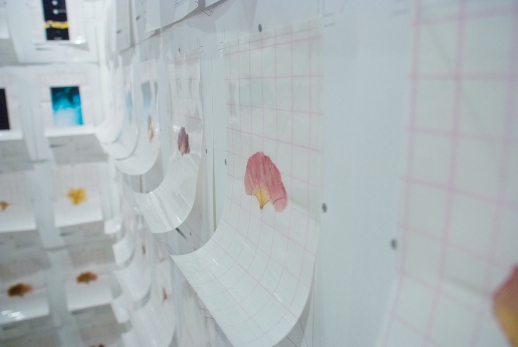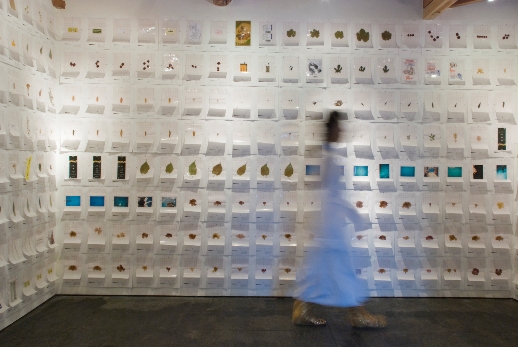To Share Realities
To “publish”. Multi-disciplinary artist Megumi Matsubara has designated this as the act of simply picking up an object for our enjoyment and then presenting it somewhere else. What has been published in this exhibition is a collection of 1000 objects, pressed flat and collected during a month-long trip in Europe, and displayed in a time-sequential grid that covers all the walls of the intimate space of Art Center Ongoing. The neatly aligned exhibits give at first the impression of a methodical scientific research, of an assemblage of specimens. The package of bowling socks, a flight ticket, remnants of a game played with friends and other traces of everyday life amongst the myriad of flower petals and other pressed leaves: the viewer promptly discovers that each object is labeled with the time and place in which it was collected, and is a record of a lived moment to which the viewer is invited to participate.
Archaeologist Michael Shanks states that the construction of archaeological knowledge must by its nature be a creative and poetic event because “it is all about absences, about writing around what is obstinately not there”. Archaeology should therefore “entertain no final account of the past as it was, but instead foster multivocal and multiple accounts”.1 Similarly, the exhibition entirely depends on the active involvement by, in other words the performance of, the viewers. Viewers are tacitly requested to generate in their minds situations and narratives through each of the objects. The lack of more information, information that the artist could have easily added, such as brief diary-like texts, attests to this understanding. This undulating space and time that is generated between the object and the viewer, this is where the exhibition resides.

Evolutionary biologist Richard Dawkins claims that reality is a fiction in that all living organisms perceive reality in ways that facilitate their own survival. Thus human beings operate in a “middle world” where, for example, we perceive objects as solid even though they are mostly composed of emptiness at the molecular level.2 We therefore unconsciously select information that makes our daily lives possible. This is apparent even without having to go into significantly different scales of dimensions or time. Even in our daily lives we spontaneously select information to be recognized while discarding a multitude of others, just like our eyes focus only on certain things. Reality as we perceive it is a construction, or more precisely a constant production.
Matsubara sought to float this ongoing unconscious process up to the level in which it may be consciously recognized. She sought to record it, to “record the flow of her own consciousness” to use her own words, the fluctuating state of herself in the particular surroundings with its objects of that moment. It was interesting to see her photographs from the trip during the talk that she gave at the gallery. Her trip immediately became banal and the conversation that was established between her trip and us viewers through her objects turned into a monologue, as she pointed out herself. This is why Matsubara attempted a different modality of recording, one that allowed her to open up her own experience, her own reality, to the dynamic intervention and re-articulation by others.
Why 1000 objects?
This is even more apparent as we understand the reason behind the limit for the total number of objects to be collected. The number 1000 was defined by a project the artist was offered to join about the same time she set out on the trip, namely the participation in the small scale Swedish art publication Museum Paper.
Museum Paper only releases 1000 copies of each edition. Unlike other artists who chose to present their works in a conventional publishing format, Matsubara decided to include one actual object from her trip in each copy of the publication. The objects will therefore travel to Sweden first to be bound and then to readers who will happen to pick up a copy of the publication. The exhibition will never be complete; it will continue to exist as an ongoing process wherever and whenever a reader opens the page. “I rely on viewers”, said the artist towards the end of her talk, summarizing the co-operative/co-performative nature of this project.

Sharing realities online
This process of editing and collecting information, and subsequently publishing it to be shared by a wide audience is reminiscent of a social and technological phenomenon that seems to be at the tip of everyone’s tongue recently: Twitter. Leaving aside the differences in terms of scale, speed and modality, as well as the inherent complexities and problems involved which go completely beyond the scope of this review (and which this writer still fails to grasp fully), it is worth pointing out the similarities between the artist’s project and the internet service.
The explosion of the usage of Twitter can be understood as our willingness to do just what Matsubara has done in her project, to employ a more acute awareness of the situation surrounding her, to select objects (information) that she would like to use to simultaneously record her reactions and thoughts while also “publishing” them to be shared. It is the recording and sharing of the process involved in the ceaseless production of realities.
Actually picking up objects and pressing them in a large phone book that the artist carried around wherever she went, not to say “publishing” them in an exhibition and then in a Swedish publication, is undeniably a process that necessitates an incomparable amount of effort, willingness, and, I’m tempted to say, care, in comparison to writing 140 words that can instantly be published with a click. “Poetry makes language care because it renders everything intimate…There is often nothing more substantial to place against the cruelty and indifference of the world than this caring.”3 Matsubara’s exhibition envelops us and confronts us with this kind of poetic “labor of bringing into intimacy” that John Berger writes about, inviting us to travel with her while reconsidering the very essence of the way we do and can relate to each other.
—
1Pearson, M & Shanks, M (2001) Theatre/Archaeology, Routledge, London
2Dawkins, R (Jul 2005) Queerer than we can suppose
3Dyer, G (Eds) (2001) John Berger: Selected Essays, Bloomsbuy Publishing, London
Naoki Matsuyama
Naoki Matsuyama



